Wicklow Beauties
Wicklow, Ireland
Overview
Wicklow, known as the “Garden of Ireland,” is a county in Ireland. It is characterized by its diverse landscapes, which are among the most picturesque in Ireland, has a rich history, with evidence of human settlement dating back to ancient times. Wicklow’s economy is diverse, including agriculture, tourism, and small industries. The county is a popular residential area, particularly for those working in Dublin, due to its proximity to the capital and high quality of life. Wicklow is well-connected because of road, rails and public transport. Major roads like the M11/N11 connect Wicklow to Dublin and the rest of Ireland. The county is also served by rail lines, with regular train services from Dublin to coastal towns like Bray and Greystones. Bus services operate throughout the county, linking towns and rural areas with major cities. Wicklow offers a blend of outdoor recreation, cultural experiences, and a relaxed lifestyle. The county’s towns and villages are known for their community spirit and high standard of living. The county hosts various events, including the Wicklow Arts Festival, Bray Jazz Festival, and a variety of agricultural shows and markets.
Neighborhood
Here are some famous places to visit in Wicklow:
1.Glendalough
A picturesque valley known for its stunning lakes, ancient monastic settlement, and walking trails. Glendalough is best known for its early medieval monastic settlement, founded in the
6th century by St. Kevin, a hermit priest who chose the tranquil valley for prayer and solitude. Over time, the site developed into a prominent religious center, attracting monks and pilgrims. The monastic city continued to thrive until it was destroyed by English forces in 1398.
It is situated within the Wicklow Mountains National Park, an area known for its scenic landscapes and diverse wildlife. The valley is dominated by two lakes, the Upper and Lower Lakes, which are surrounded by wooded hills and steep glacial cliffs. This natural setting provides a serene and picturesque backdrop for visitors.
Glendalough offers a range of activities and attractions for visitors, like Walking and Hiking Trails, the area boasts numerous trails of varying difficulty, including the popular Spinc and Glenealo Valley Loop, which offers stunning views of the valley and lakes. Nature and Wildlife, the surrounding national park is home to diverse flora (plants and flowers) and fauna (animals and birds), including native Irish species like red deer, badgers, and various bird species. Visitor Centre, the visitor center provides educational exhibits about the history of the monastic site, the geology of the area, and the flora (plants and flowers) and fauna (animals and birds) found in the valley. It also serves as a starting point for exploring the site. Cultural Events, the site occasionally hosts cultural events, including guided tours, storytelling, and traditional Irish music sessions, particularly during festivals or heritage weeks.
Glendalough remains a place of pilgrimage and spiritual reflection for many visitors. Its serene atmosphere and historical significance continue to attract those interested in Ireland’s religious heritage and early Christian monastic life.
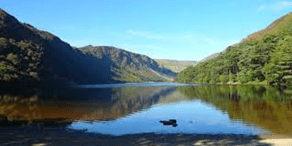
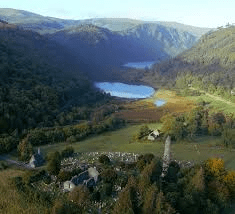
2.Powerscourt Estate and Garden
Powerscourt Estate is a grand estate in Enniskerry, County Wicklow, Ireland, known for its impressive mansion and beautifully landscaped gardens. It’s a popular tourist destination, celebrated for its history, architecture, and stunning natural setting. Here’s an overview of what makes Powerscourt Estate remarkable:
Powerscourt House
- Architecture: The main house at Powerscourt Estate is an elegant example of Palladian architecture, originally designed by Richard Cassels in the 18th century. The house was extensively renovated in the 19th century by the 7th Viscount Powerscourt, featuring a blend of Palladian and Victorian styles.
- Interior: The mansion houses a range of shops, a café, and a terrace restaurant, offering visitors a chance to enjoy the views of the gardens and surrounding countryside. The house also contains exhibits that showcase the history of the estate and its former residents.
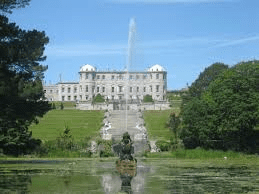
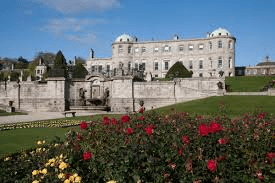
Powerscourt Gardens
The gardens at Powerscourt are among the finest in Europe, meticulously laid out over 47 acres and featuring a variety of styles and influences. Some of the key features include:
- Italian Garden: This formal garden is inspired by classical Italian design, featuring terraced lawns, ornamental ponds, and statues. It offers stunning views of the Sugar Loaf Mountain.
- Japanese Garden: Created in the early 20th century, this garden incorporates traditional Japanese elements, including pagodas, stone lanterns, and water features, set among lush plantings.
- Walled Garden: A charming area filled with colorful flower beds, herbaceous borders, and a collection of rare plants.
- Triton Lake: Dominated by a large fountain based on the one at Piazza Barberini in Rome, Triton Lake is a focal point of the estate, surrounded by trees and walking paths.
- Tower Valley: Known for the distinctive Pepperpot Tower, inspired by a pepper grinder, this area provides a whimsical feature amidst woodland walks.

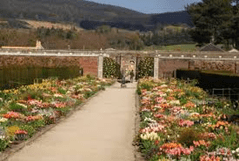
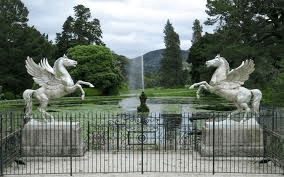
Powerscourt Waterfall
Located about 6 km from the main estate, Powerscourt Waterfall is Ireland’s highest waterfall, cascading 121 meters (397 feet). It’s set in a scenic parkland with picnic areas and walking trails, making it a popular spot for family outings and nature lovers. The waterfall is nestled in a lush valley filled with native oak, beech, and pine trees. This area is rich in wildlife, including deer, red squirrels, and various bird species. The site around the waterfall is a favorite destination for picnicking, walking, and enjoying the scenic views. The grounds are equipped with facilities such as picnic benches and restrooms, making it accessible for families and visitors looking for a leisurely day out.
Powerscourt Waterfall is open to the public, and a small entrance fee is typically charged to help maintain the site. The waterfall can be visited year-round, though the volume of water can vary depending on the season and rainfall.
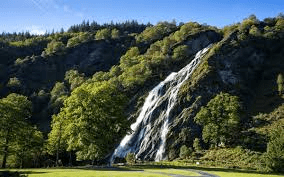
Powerscourt Golf Club
The estate is also home to the Powerscourt Golf Club, which features two championship golf courses. These courses are set amidst the stunning landscapes of the estate, offering players beautiful views and challenging play. Powerscourt Golf Club has hosted various prestigious tournaments and events, both amateur and professional, showcasing the quality of its courses. The club also offers facilities for corporate events, weddings, and other social gatherings, leveraging its picturesque setting. The club caters to both members and visitors. It offers various membership packages, catering to different needs and playing frequencies. Visitors can book tee times to experience the courses, with options available for individuals and groups. The club provides comprehensive facilities, including a clubhouse with a pro shop, locker rooms, and dining options. The clubhouse offers panoramic views of the courses and surrounding countryside, creating a relaxed and inviting atmosphere for golfers.
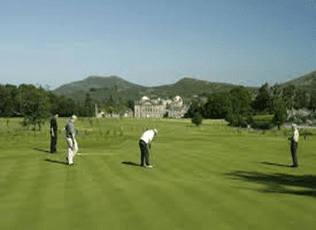
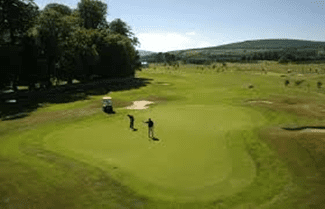
Events and Activities
Powerscourt Estate hosts a variety of events throughout the year, including garden tours, seasonal festivals, and outdoor concerts. The estate’s beautiful setting also makes it a popular venue for weddings and special occasions.
3.Wicklow Mountains National Park
Wicklow Mountains National Park is one of Ireland’s most beautiful and extensive natural landscapes, covering approximately 20,000 hectares (around 49,400 acres) in County Wicklow. Established in 1991, it is Ireland’s largest national park and a haven for nature lovers, outdoor enthusiasts, and anyone interested in exploring Ireland’s rich biodiversity and scenic beauty. Wicklow Mountains National Park is characterized by a diverse range of habitats, including heathlands, bogs, woodlands, and alpine habitats. The park is home to unique plant species
such as heather, bilberry, and bog cotton. Woodlands include native oak, Scots pine, and birch. Wildlife includes red deer, sika deer, mountain hares, and the rare Irish hare. Bird species like peregrine falcons, merlins, and hen harriers are also found here.
The park is a popular destination for various outdoor activities, attracting both locals and tourists:
- Hiking and Walking: The Wicklow Way, a long-distance trail, traverses the park and offers stunning views of the landscape. Other popular walking routes include trails around Glendalough and the challenging climb to the summit of Lugnaquilla.
- Cycling and Mountain Biking: The park offers several routes suitable for cycling, including both on-road and off-road options.
- Fishing: The park’s rivers and lakes provide opportunities for angling, particularly for trout and salmon.
- Rock Climbing and Bouldering: The granite formations of the Wicklow Mountains offer excellent climbing opportunities.
The park plays a vital role in the conservation of Ireland’s natural heritage. It is managed to protect its unique landscapes, habitats, and species. The park authorities also focus on environmental education, offering guided walks, educational programs, and visitor centers with exhibits on the natural and cultural history of the area.
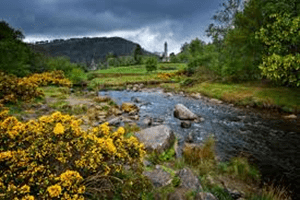
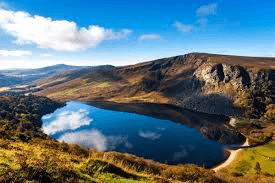
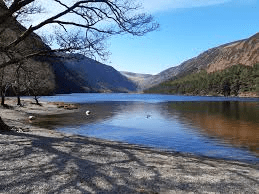
4.Lough Tay
Often referred to as the “Guinness Lake” due to its distinctive color and shape, Lough Tay is a small but striking lake nestled in the Wicklow Mountains. It’s a popular spot for photography and enjoying the natural scenery. Lough Tay is situated within the privately owned Luggala Estate, part of the Wicklow Mountains. It lies approximately 30 kilometers (19 miles) south of Dublin and is accessible via the R759 road. The lake is particularly famous for its unique appearance, which resembles a pint of Guinness. This is due to the dark color of the water, caused by the peat in the surrounding boglands, and the bright sandy beach at its northern shore, which resembles the head of a pint.
The lake is nestled between the steep slopes of Luggala Mountain (also known as Fancy Mountain) and the surrounding hills, creating a dramatic and secluded atmosphere. The area around Lough Tay is characterized by heather-covered moorlands, bogs, and native woodlands, contributing to its rich biodiversity and scenic beauty.
Activities and Accessibility
- Hiking and Walking: The area around Lough Tay offers numerous trails and walking routes, including parts of the Wicklow Way, which passes nearby. The trails provide opportunities for exploring the natural beauty of the region.
- Photography: Due to its picturesque setting, Lough Tay is a popular destination for photographers looking to capture the unique landscapes of the Wicklow Mountains.
The natural landscape around Lough Tay is part of a protected area, and efforts are made to conserve its unique environment and biodiversity. Visitors are encouraged to adhere to the Leave No Trace principles to minimize their impact on the area.
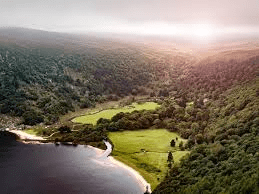
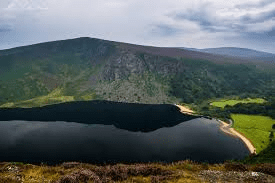
Close Proximity
1.Dublin
The part of Dublin that is closest to County Wicklow is South Dublin. This area includes the southern suburbs and districts of Dublin city, which gradually transition into the scenic landscapes of Wicklow. Approximately 50 km (31 miles) north of Wicklow, Dublin is the capital and largest city of Ireland. It’s a vibrant city with a rich history, cultural attractions, and lively nightlife.
Wishie Homes have broader prospects in Dublin to visit Wicklow spread across Leopardstown, Gallops reachable in 15-20 mins drive and 45 mins by Dublin Bus.
2.Bray
A coastal town at the northern tip of County Wicklow, Bray is about 20 km (12 miles) from Wicklow town. It’s known for its scenic seaside promenade, the Bray Head cliff walk, and a range of restaurants and cafes. Bray is also a gateway to the Wicklow Mountains.
3.Greystones
Located around 15 km (9 miles) north of Wicklow town, Greystones is a charming seaside town known for its beautiful beaches, harbor, and the start of the Bray to Greystones cliff walk. It has a friendly community vibe with good restaurants and cafes.
4.Avoca
Around 20 km (12 miles) southwest of Wicklow town, Avoca is famous for its handweaving mill and the Avoca Handweavers shop. The village is also known for its beautiful countryside and was a filming location for the TV series “Ballykissangel.”




